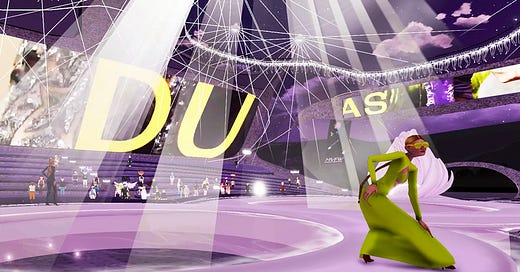What’s the point of (a virtual) fashion week?
Channeling Carrie Bradshaw and asking the BIG QUESTIONS over here.
As many of you will have seen, MVFW happened last week. There’s been a lot of glowing discussion and a lot of critical discussion, and both are great and necessary. But apples-to-apples comparisons to IRL (in real life) fashion week probably left most users wanting.
A la Carrie Bradshaw, I found myself at my laptop asking, What’s the point of fashion week?
We all know the history. Originally a trade show intended to show buyers and the press, maybe VIP clients, it has morphed into a social media marketing bonanza—a necessary and wonderful evolution for the Web2.0 age. Crazy, stunning displays of creativity deserve to be seen by a wide audience. For most brands, exclusivity is “out” at least at the mass level when you’re trying to sell millions of wallet cases and lipsticks. Lastly, in our celeb-driven Instagram feeds, we NEED those FROW pics of Rihanna. NEED.
In the metaverse, did we achieve this? Let’s look at a few things. Creativity. Exclusivity. Instagram eyeballs. Clothes and accessories to sell.
Creativity. In the metaverse, we have unlimited options for creativity. Did the designers make use of them? Not really. Dolce and Dundas showed on the same kind of dull, futuristic catwalk. Most of the stores looked kind of similar. Certainly we didn’t see all that I imagine a metaverse event to be capable of. This is a limitation of the platform and the computers we are using today, so let’s assume with time this could/will change, but for now, I think MVFW missed the boat on that application of creativity. And clothes-wise, the same. Is it digital fashion? Is it for IRL fashion? Who’s the audience? I don’t think anyone was holding these displays up to Cathy Horyn’s bar of critique. On the one hand, neat, tech first. On the other, if it’s not better, why bother?
Earlier in March, Vogue Business and Yahoo hosted a Metaverse Experience event that was much more attractive visually and seemed to function more smoothly, showing off their expertise in the space. Of course, that’s a B2B audience of Vogue Business readers and not apples-to-apples but a useful comparison. We might think of it more like fashion shows of the 1950s, e.g., industry-focused. If you’re trying to lure brands to the metaverse on the premise of stunning visuals, this was much slicker.
Exclusivity/Inclusivity. Well, I think it was accidentally exclusive due to technology hiccups, but otherwise, A+ for this. Letting anyone experience the excitement of fashion week is a real breakthrough and gives brands a lot more reach as well as bang for their buck in terms of the effort that goes into fashion shows. Affiliative social engagement is the term for moments when people, in person, experience together, like seeing others moving to the rhythm of the music at a concert, when everyone applauds together after a play, or when a crowd laughs at a funny
joke. Studies have shown that while this moment in time increases people’s
feelings of engagement with those around them, it doesn’t have to be
in-person to work. Virtual noises from others, either in real-time or prerecorded,
can produce the same convivial effects. So there’s no reason that MVFW couldn’t be visually moving. But, we should ask anyone who’d been at, say, an Alexander McQueen show that was so beautiful it brought tears to their eyes to tell us how far we are from that communal emotion happening in the metaverse.
Social media power. Basically zilch. Without celebs (except for Grimes…), without outrageous sets or horses coming down the runway, without stunning designs, you aren’t going to get a lot of traction. Also, do you screenshot? Take a pic of your monitor? Awkward.
One thing I was struck by during MVFW is the old-fashioned way the Metaverse allows for a continuous customer journey, from discovery to purchase, much like walking into a new shop while wandering about town. You can go from discovery to purchase in a heartbeat which is pretty challenging for DTC brands with no physical footprint. Something to chew on.
A different way to explore this for digital fashion was just announced by DressX and Printemps, the Parisien department store. Another way to acquire customers is to put digital fashion in physical stores. Be still my heart. What fun to be in a department store and get to try on virtual clothes on a life-size screen. Kudos on both sides for the innovation.
Lastly, onto the new collection aspect. Given the visuals in Decentraland, the designs were a long way off from a. What we see in real life or even b. Something like Dolce’s first foray into digital fashion, with what was really couture-level design.
I want to highlight here the talent of virtual first designers who spend hours crafting exquisite designs with cutting-edge technologies. I had the chance to interview Nina Ibañez
of ENYE about her process. It was enlightening how close to couture the design efforts are now since the technology and skillsets are still evolving. I’ll send that interview out next week.
If you like what you’re reading here, be sure to subscribe or share with your friends.





